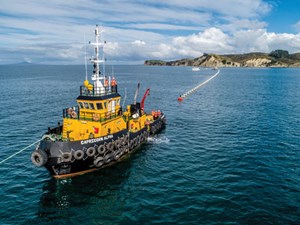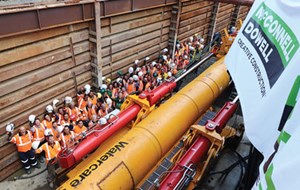March 2019 Vol. 74 No. 3
Features
Breaking Records in a Conservation Park
Another Direct Pipe Record Falls in New Zealand
Watercare Services Ltd., located in Army Bay, Auckland, New Zealand, engaged McConnell Dowell and design partner McMillen Jacobs, in March 2017, to increase the outfall capacity for its Army Bay Wastewater Treatment Plant at Shakespear Regional Park on the Whangaparaoa Peninsula. The project involved installing a new wastewater outfall, upgrading the existing pump station and building a new ultraviolet disinfection facility.
Shakespear Regional Park (SRP) is a pest-free conservation area, home to a variety of native wildlife including Kiwi, Little Blue Penguins and skinks, so choosing a construction methodology that minimized impacts on the area was important. A technology called Direct Pipe, developed by German manufacturer Herrenknecht, had never been used before in New Zealand, but officials believed it was ideal for this project as it enables small-diameter pipelines to be installed over large distances more accurately than traditional trenchless tunneling techniques.
The new outfall and ancillary buildings had to be built within the SRP without impacting the operational capability of the existing wastewater treatment plant. Key stakeholders including Auckland Council, Watercare, New Zealand Defence Force (NZDF), local Kiwi and the Shakespear Open Sanctuary Society Incorporated (SOSSI) all played a part in the management of the regional park area.
The park area is defined by a pest-proof fence that runs from Army Bay across the Whangaparaoa peninsula. Along with trapping and other preventative measures, the fence helps keep predators out, giving sanctuary to endangered animals such as the Little Brown Kiwi.
Most of the construction took place within the conservation area, so it was important that the site footprint be kept as small as possible, work was undertaken efficiently and environmental risks well-managed.
Solution
Herrenknecht’s Direct Pipe was selected as the tunneling methodology for this project because planners believed it would be the most-efficient and safest way to install the pipeline at Army Bay. For this project, only an entrance and two maintenance shafts, (excluding the dredged offshore retrieval pit) were required to install the pipeline, which reduced the overall site footprint required.
The ability to install long pipe strings in a single drive reduced the amount of time required for construction and the controlled slurry pumping process lowered the risk of drilling fluid entering the surrounding environment.
All these benefits, along with the fact that Direct Pipe only requires minimal manned entry, made it the ideal technology for the project.
State-of-the art Direct Pipe tunneling technology enabled McConnell Dowell to mitigate many of the significant risks faced by the Army Bay project. Direct Pipe has the benefits of microtunneling, such as more control over speed, direction and cutter-head pressure, with better slurry management systems. This allows pipe to be installed efficiently and economically almost 5,000 feet in a single drive. Direct Pipe also offers other benefits including increased safety and less risk, minimized personnel entry, improved accuracy and the capability to handle harder materials.
Best practice environmental planning was also crucial to mitigate the risks associated with building infrastructure amongst protected flora and fauna.
One of the first examples of environmental impact mitigation was clearing the worksites of vegetation and wildlife prior to construction. An ecologist supervised this process, catching and safely relocating several threatened lizard species such as the Moko, Copper and Green skinks. All the information the ecologist collected during the project was captured in a national data base contributing to the body of knowledge New Zealand science has for these rare animals.
TBM
A state-of-the-art, new Herrenknecht Tunnel Boring Machine system was used for the tunneling portion of the project. Named Blanche, after the matriarch of the pioneering Shakespear family for whom the park is named, the TBM was an impressive 37-ton, 42.65-foot-long Herrenknecht AVN1000DP. It had a cutter head diameter of 1,325 mm and dual pipe thrusters with a combined available thrust force of 1,460 tons. The $3-million TBM arrived in five segments and took the team about three weeks to assemble and commission.
The Direct Pipe method was used to pipejack a 1.24-mile-long 1,200-mm-outside-diameter steel carrier pipe, with a 1,100-mm diameter HDPE liner, 147.64 feet deep from the new pump house to a transition point in the Hauraki Gulf.
This is the first time this method has been used in the Southern Hemisphere and the team set a world record for the longest Direct Pipe drive, at 6,239 feet during installation. That represented more than 30 percent further than the previous record of 4,904 feet.
The outfall pipeline runs 1.18 miles from the treatment plant to the marine transition where the 2,953-foot marine pipe section begins. This section is an 80-mm-diameter HDPE pipe with 233, 2.4-ton concrete ballast blocks attached. It was assembled at Kaiaua in the Firth of Thames and towed 40 nautical miles up to Army Bay, where it was installed into position by controlled sinking in August 2018.
Sliplining
The extremely constrained site meant lining the 1.18-mile pipe with HDPE, which also presented significant challenges for the team. It was literally stuck between the small amount of space available at one end of the pipe and the ocean at the other. The limited space available at the launch site restricted the welding operation to 328-foot-long pipe strings. Installing the HDPE pipe using conventional pulling meth- ods from the ocean end would have required a marine operation with barges and winch lines, leaving the team at the mercy of sea conditions and extending the construction program.
As well as facing two difficult choices at either end of the pipeline, the team was also squeezed in the middle. On standard sliplining projects, pipe is fed from one end and a wire rope is used to pull from the opposite end. But sliplining the HDPE pipe in one continuous string using standard methodology would have generated a large amount of frictional force with potential to compress the HDPE pipe. By the time it was pushed through the carrier pipe, it would be 49 feet shorter.
An innovative sliplining method was developed that enabled workers to navigate the site constraints, reduce the amount of compression on the HDPE pipe and safeguard the program.
HDPE pipe is buoyant in water, so the loads required to move it are significantly lower than in dry pipe. By floating the HDPE pipe into position, the team was also able to reduce the friction loading and stress, maintaining the integrity of the pipe. Filling the pipe with water also made using a clamping unit to push the pipe in strokes feasible.
In place of thrusters, two 5-ton winches were built into the base slab and then a clamping unit was fabricated to place around the pipe, both of which were designed and constructed in-house. By welding the HDPE pipe with two welding machines and working 24 hours a day, the installation was completed in just three weeks.
Shafts
Two shafts were required for routine maintenance of the TBM. The first, a 157.5-foot-deep shaft, was dug utilizing a Soilmec piling machine. An area at the bottom of the shaft was excavated to a wider diameter, or ‘belled’ out to create the space required to receive the TBM underground. As this shaft was located on NZDF land, access was challenging, and the local topography added further complexity.
A second, 55.8-foot-deep by 8.9-foot-diameter shaft was constructed by the coast (also on NZDF land) and was the final land shaft the TBM passed through on its way out to the Tiri Channel.
The TBM’s cutter head and tooling required inspection after covering a certain distance, depending on the advance speed and ground conditions. Undertaking these inspections required retracting the machine. However, due to the limited working space at Army Bay, the crew opted to install the two maintenance shafts along the 1.18-mile route.
The two, 800-mm-diameter HDPE pipe strings were assembled in Kaiaua, with 56-foot sections of the pipe welded to create the pipe strings. These were then pulled and stored on a narrow embankment between a quarry pond and the Firth of Thames.
Despite a severe storm in January that flooded the community, damaging roads and raising the sea level high enough to go over the embankment, the pipes remained where they were laid and stayed dry inside.
The pipes were then pressure tested, clamped with ballast blocks and floated at high tide, and towed out to sea and up to Army Bay.
Along with the trenchless pipeline installation, a pump station was upgraded and relocated, and a new Duron UV treatment facility in the Watercare site at Army Bay was installed. Overall, the expansion has the capability to effectively treat wastewater at a rate of 370 gallons per second, up from 90 gallons per second, and has a 100-year design life.
Environmental, stakeholder management
Army Bay’s neighbours include the Shakespear Regional Park, a highly sensitive conservation area and an operational NZDF training site. The decision to use Direct Pipe to install the pipe was key to minimizing impacts on wildlife and the surrounding environment, as it reduced the number of shaft sites required, and their overall size. The engineering/design team liaised with stakeholders, such as the council and SOSSI, to mitigate environmental risks and worked closely with the NZDF to ensure safety was a priority.
Strict procedures were in place to clear sites of any unexploded ordinance and manage access around the sites while safety-crit ical operations, such as live-firing exercises, were underway. The SRP pest-free enclave is home to more than 20 Brown Kiwi breeding pairs, as well as the endangered Moko skink so a huge effort was put into animal search and relocation before and during construction.
As well as relocating wildlife, the staff received environmental awareness training, enabling them to identify protected species and their preferred habitats. Extensive controls were in place throughout the project and while clearing vegetation from the coastline. Following one of these control processes, staff found a Little Blue Penguin (Kororā). The adventurous penguin, who was onshore to molt in a Pampas grass burrow, was cared for overnight and returned to a new, custom-dug burrow, a safe distance from the worksite. •






Comments